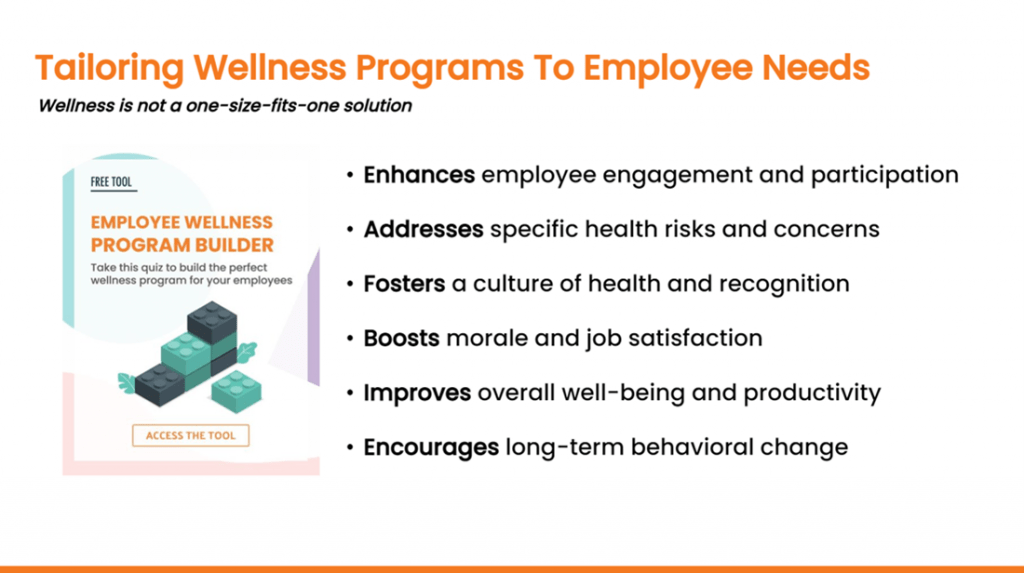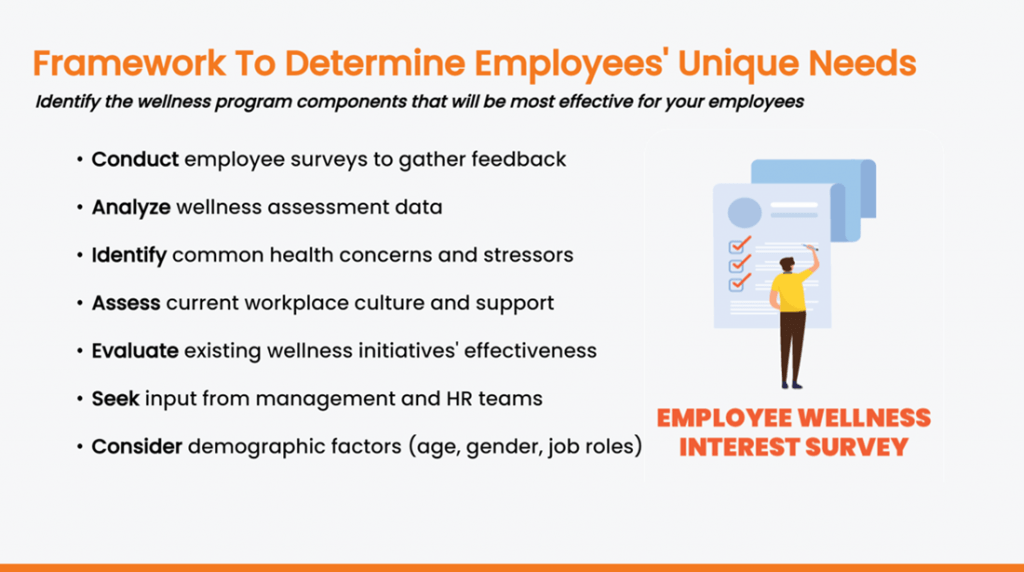Introducing our brand-new “Insights for Success” blog series! We’ve gathered all the questions that were submitted during our recent webinar on employee wellness and engagement and compiled them into one convenient place. Now you can access all the valuable insights and answers in a single location!
In our recent webinar, “Insights For Success: Uncovering 2023 Employee Wellness & Engagement Trends”, Wellable partnered with Bucketlist Rewards to help employers pinpoint areas of focus for employee wellness efforts. Experts Geoff Geredian, Chief Growth Officer at Wellable, and Aaron Johnson, Culture Advocate at Bucketlist Rewards, unpacked a wealth of knowledge, including the latest employee wellness trends, secrets to employee wellness program engagement, and strategies for ensuring wellness program success from the start.
We understand that not everyone could attend the live session, so we’re bringing the insights to you. We’ve curated and answered the top wellness-related questions discussed during the event. Curious about how personalized rewards boost employee motivation? Or about the crucial role of mental health support in today’s workplace? We’ve got that covered and more! Join us as we delve into the valuable insights that will help you craft an unbeatable wellness strategy for the year ahead.

1. How would you assess wellness’s contribution to company culture?
Organizations can assess wellness’s contribution to culture through a combination of quantitative and qualitative measures. Quantitative measures may include analyzing wellness program engagement rates, employee retention, performance, and productivity. It’s worthwhile to evaluate the correlation between program participation and core performance and retention metrics. Another approach is to track health outcomes such as reduced absenteeism and lower healthcare costs.
Qualitative measures may include conducting surveys or focus groups to gather feedback on employee satisfaction, stress levels, and overall well-being. By combining these methods, companies can gain a holistic understanding of how their wellness programs impact company culture, enabling them to make informed decisions to optimize initiatives for the benefit of both employees and the organization at large.
2. How can organizations with little to no wellness budget effectively engage staff? How can they get started with zero budget?
Even with little to no wellness budget, there are several ways organizations can engage their staff in a meaningful way. Here are some suggestions on how to get started:
- Encourage physical activity: Encourage employees to take breaks and stretch during the day, organize walking or running groups, or offer standing desks to promote movement.
- Offer healthy snack options: Provide healthy snacks like fruits, nuts, and vegetables in the break room or vending machines to encourage healthy eating habits.
- Promote mental wellness: Encourage employees to take mental health breaks, offer resources for stress management, and create a supportive and inclusive workplace culture.
- Organize wellness challenges: Create fun wellness challenges that don’t require expensive equipment or resources, such as step challenges, meditation challenges, or healthy eating challenges. Try out Wellable’s free step challenge template here.
- Leverage free resources: Share free online resources, such as wellness blogs, videos, and podcasts, with employees to encourage healthy behaviors. Check out Wellable’s favorite free workplace wellness resources here.
By starting small and building from there, organizations can create a culture of health without breaking the bank. With time and effort, organizations can cultivate an environment that prioritizes the well-being of its employees, resulting in a happier, healthier, and more productive workforce.
3. How can organizations encourage remote employees to engage in wellness initiatives?

Encouraging remote employees to engage in wellness initiatives can be challenging, but there are several tips that can help:
- Communicate regularly: Regular communication is key to engaging remote employees. Keep them informed of wellness initiatives, challenges, and events through regular emails, newsletters, or team chat channels.
- Offer virtual wellness programs: Offer virtual wellness programs, such as on-demand fitness classes, mental health webinars, and online health coaching.
- Provide wellness resources: Provide resources such as e-books, podcasts, or blogs that promote wellness and healthy habits. Explore Wellable’s favorite free workplace wellness resources here to get started.
- Encourage breaks: Encourage regular breaks throughout the day to stretch, move, and disconnect from work, preferably outdoors, if possible.
- Foster a sense of community: Organize virtual team-building activities, such as virtual team lunches, wellness challenges, or online games.
- Lead by example: Encourage leaders and managers to prioritize their own wellness, inspiring remote employees to do the same.
Creating a culture of wellness for remote employees requires creativity, communication, and commitment. By providing a variety of resources and opportunities to engage in wellness initiatives, remote employees can feel supported and motivated to prioritize their health and well-being, regardless of location.
4. What are current trends for encouraging physical well-being? Are companies doing wellness changes such as The Biggest Loser? If so, are there any incentives for participants?
Several physical well-being trends are gaining popularity among companies. These include:
- Flexibility and variety: Companies are offering a wider range of physical activities and programs, such as yoga, Pilates, dance classes, and outdoor activities, to accommodate different interests and fitness levels.
- Wearables and tracking tools: Wearables and tracking tools, such as fitness trackers and smartwatches, are used to help employees monitor and track their physical activity levels
,and encourage healthy behaviors. - Mind-body connection: Companies now recognize the importance of mind-body connection and are incorporating practices such as meditation, mindfulness, and breathwork into their physical well-being programs.
- Virtual workouts: Virtual workouts and online fitness classes are becoming more popular, especially in light of the COVID-19 pandemic, as they allow employees to participate regardless of location.
Regarding “The Biggest Loser” approach, some companies implement weight-loss challenges or programs; however, they are increasingly viewed as problematic due to their focus on weight as the sole marker of health. It’s recommended to take a holistic approach to physical well-being, focusing on behaviors such as regular physical activity, healthy eating habits, and stress reduction rather than weight loss. Offering incentives like monetary rewards can encourage these behaviors, but non-monetary rewards such as recognition, extra time off, or priority parking spaces can also be effective.
5. What’s the best way to invest wellness dollars?
The best way to invest wellness dollars is through holistic wellness initiatives. Rather than focusing on one area, such as physical fitness or nutrition, investing in a comprehensive program that addresses all aspects of wellness yields the greatest return on investment.
This can include initiatives that support physical health, such as fitness programs and healthy eating options, and mental health programs, like stress reduction, mindfulness, and counseling services. Programs that promote a healthy work-life balance, such as flexible schedules and telecommuting options, can also significantly impact employee well-being.
Additionally, investing in technology and tools such as wearables, health coaching, and data analytics can help track employee engagement and progress while providing personalized recommendations and support.
Ultimately, the best way to invest wellness dollars will depend on the unique needs and goals of each organization. A well-designed program that is tailored to the specific needs of the organization and its employees can lead to improved productivity, engagement, and overall well-being.
6. Can you recommend any specific platform to track employee wellness, fitness challenges, suggestions, etc.?
As a wellness provider, Wellable highly recommends our own platform to track employee wellness, fitness challenges, suggestions, and more. Wellable’s Wellness Platform is designed to provide a comprehensive and engaging wellness experience for employees, offering a range of features that are customizable to the unique needs and goals of each organization.
Our platform includes wellness assessments and challenges, educational content, rewards tracking, on-demand classes, on-site & virtual experiences, and more. It also integrates with a variety of wearables and other wellness tools, making it easy for employees to track and monitor their progress.
We pride ourselves on our user-friendly interface, which encourages high levels of employee engagement and participation. We also offer a range of support services, including wellness coaching and program management, to help organizations achieve their unique wellness goals.
Overall, Wellable’s platform provides the ideal combination of features, flexibility, and support to help organizations of all sizes and types create a successful wellness program that’s tailored to the specific needs of the organization and its employees.

7. Are you seeing any correlation between poor wellness program participation/ adoption and financial health, specifically from delayed or deferred care?
Poor wellness program participation and adoption can have a negative impact on financial health, particularly when it comes to delayed or deferred care.
When employees do not prioritize their health and well-being, they may delay seeking necessary medical care, leading to more serious and costly health issues down the road. This can result in increased health care costs for both the employee and the employer, as well as decreased productivity and higher rates of absenteeism.
On the other hand, a comprehensive and engaging wellness program can encourage employees to prioritize their health, leading to early detection and treatment of health issues, reduced health care costs, and improved productivity and job satisfaction.
This is why it’s crucial to customize wellness programs to the unique needs and goals of each organization’s employees. By providing resources, incentives, and support for healthy behaviors, organizations can create a culture of wellness that promotes both physical and financial health.
Overall, investing in employee wellness is a smart financial decision that can pay off in the long run by promoting the well-being of employees, reducing health care costs, and improving overall business performance.
8. Can you review your policy for having spouses enter the wellness program system to receive wellness points?
The well-being of an employee’s family can significantly impact their own health and productivity. Therefore, we encourage employees to invite their spouses or domestic partners to participate in our wellness program and earn points towards rewards.
To ensure points are earned fairly and accurately, we require that the employee’s spouse or domestic partner create their own account and sign up as a separate user. This ensures that they have access to their own health information and can participate in activities and challenges that are appropriate for their own health and fitness level.
Some employers may limit the number of points that a spouse or domestic partner can earn to ensure that employees remain the primary focus of the wellness program.
Overall, our policy regarding spouses entering the system to earn wellness points is designed to promote the health and well-being of our employees’ entire families while ensuring fairness and accuracy in point tracking and reward distribution.
9. How can you establish a wellness program that encourages employee engagement and participation? How can you get agency participation?
Establishing a wellness program and engaging employees can be challenging. However, the following steps can help organizations create a successful program and encourage participation:
- Leadership support: Gain leadership buy-in and support to establish a culture of wellness throughout the organization.
- Needs assessment: Conduct a needs assessment to identify the unique wellness needs and goals of the organization and its employees.

- Program design: Design a program that includes a variety of wellness initiatives addressing the identified needs and goals of the organization and catering to the preferences and interests of its employees.
- Communication: Develop a plan that effectively communicates the wellness program and its benefits to employees. Utilize various channels such as email, company newsletters, and social media.
- Incentives and Rewards: Offer incentives and rewards that are meaningful and aligned with employee interests and goals.
- Tracking and Analytics: Utilize data and analytics to track participation and progress and make adjustments to the program as needed.
In terms of getting agency participation, we recommend engaging agency leadership and management to ensure they are aware of the wellness program and can promote it to their employees. Additionally, agencies can consider offering incentives or rewards that are relevant and motivating to their employees. It’s ideal to partner with a wellness provider that has experience working with government agencies and understands their unique needs and challenges.
By following these steps and working with a trusted wellness provider like Wellable, agencies can establish a successful wellness program that promotes the health and well-being of their employees and supports agency goals.
10. What kinds of training programs are organizations offering to improve the mental health and resilience of employees?
Training programs organizations offer to increase resilience and improve mental health among employees include:
- Stress management training: Organizations offer training programs that teach employees how to manage stress effectively, including mindfulness practices, breathing techniques, and other stress reduction strategies.
- Mental health awareness training: Mental health awareness training helps employees recognize the signs and symptoms of mental health issues, as well as strategies for supporting colleagues who may be struggling.
- Resilience training: Resilience training helps employees develop the skills and tools necessary to navigate challenging situations and bounce back from setbacks.
- Employee Assistance Programs (EAPs): EAPs provide employees with access to counseling and support services for a range of mental health issues, including depression, anxiety, and substance abuse.
- Wellness coaching: Some organizations provide one-on-one wellness coaching to help employees set and achieve wellness goals and improve their overall health and well-being.
Investing in employee mental health and resilience is crucial for creating a positive and productive workplace culture. By providing training and support programs that promote mental health and well-being, organizations can reduce stress, increase productivity, and improve overall job satisfaction among their employees.
11. What programs or tactics do you have for law enforcement and Graveyard shift employees?

Law enforcement and graveyard shift employees have unique wellness needs and challenges. For example, Wellable recently delivered chair massage sessions to a local police department organized over three shifts. This approach allowed all employees to access this relaxation benefit, even the overnight shift!
Wellable offers a range of other programs and tactics that promote wellness and improve overall well-being:
- Flexibility and variety: Wellable offers wellness programs that can be tailored to the unique needs and schedules of law enforcement and graveyard shift employees. This includes virtual fitness classes, wellness challenges that can be completed on their own schedule, and resources such as healthy meal plans that accommodate their unique shift schedule.
- Mental health support: Law enforcement and graveyard shift employees can be exposed to high levels of stress and trauma, which can impact their mental health. Wellable offers mental health support resources, such as counseling services, stress reduction techniques, and resilience training to help employees cope with stress and build mental resilience.
- Fatigue management: Graveyard shift employees can be at risk for fatigue, which can impact their overall health and well-being. Wellable offers resources and guidance on managing fatigue, such as sleep hygiene tips and guidance to optimize a sleep schedule.
- Peer support: Peer support programs helps employees connect with others who may be facing similar challenges and offers a platform for employees to share their experiences and provide support.
Wellable’s goal is to provide a range of resources and support to law enforcement and graveyard shift employees that promote their well-being and enable success both on and off the job.
12. Do you incorporate “ambassadors” to train the colleagues as part of your wellness program?
To help promote engagement and participation, Wellable often works with employee ambassadors or wellness champions who can serve as advocates for the program and help train and support their colleagues.
Ambassadors can play a critical role in promoting the wellness program and increasing participation. They can generate excitement and enthusiasm for the program, share success stories and best practices, and provide guidance and support to colleagues who may be new to wellness initiatives.
We often work with organizations to identify and train ambassadors or wellness champions, providing them with the resources and tools they need to effectively promote the program and support their colleagues. This can include training sessions, educational materials, and ongoing support and guidance from the Wellable team.
By incorporating ambassadors and wellness champions into the wellness program, organizations can build a culture of wellness that is supported by a network of engaged and motivated employees.
Can’t find your Q&A questions here? Don’t worry! Since there was tremendous interest in this topic, we couldn’t fit everything into one post. But you’re in luck! Head over to Bucketlist’s blog post and check out part 2 for all the answers you’re looking for. Happy reading!
Curious about the questions covered in Part 2? Here’s a sneak peek!
- How can I engage employees that don’t care to be engaged? How do I get my employees to stay engaged in the program? Any thoughts on how to keep people effectively engaged?
- What are your thoughts on how to get leadership to participate? I’ve seen some companies include this in leadership KPIs, making it part of their responsibility as a leader to participate.
- Are there any tips on implementing strategies for a blue-collar workforce constrained by time?
- Best communication pieces for non-adopters?












